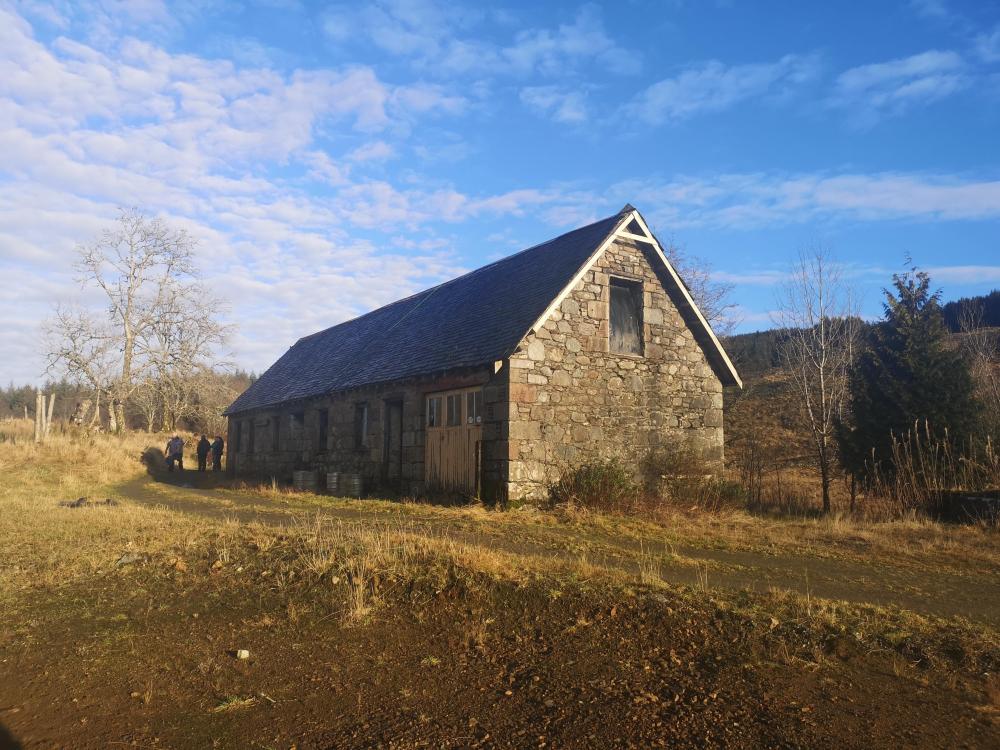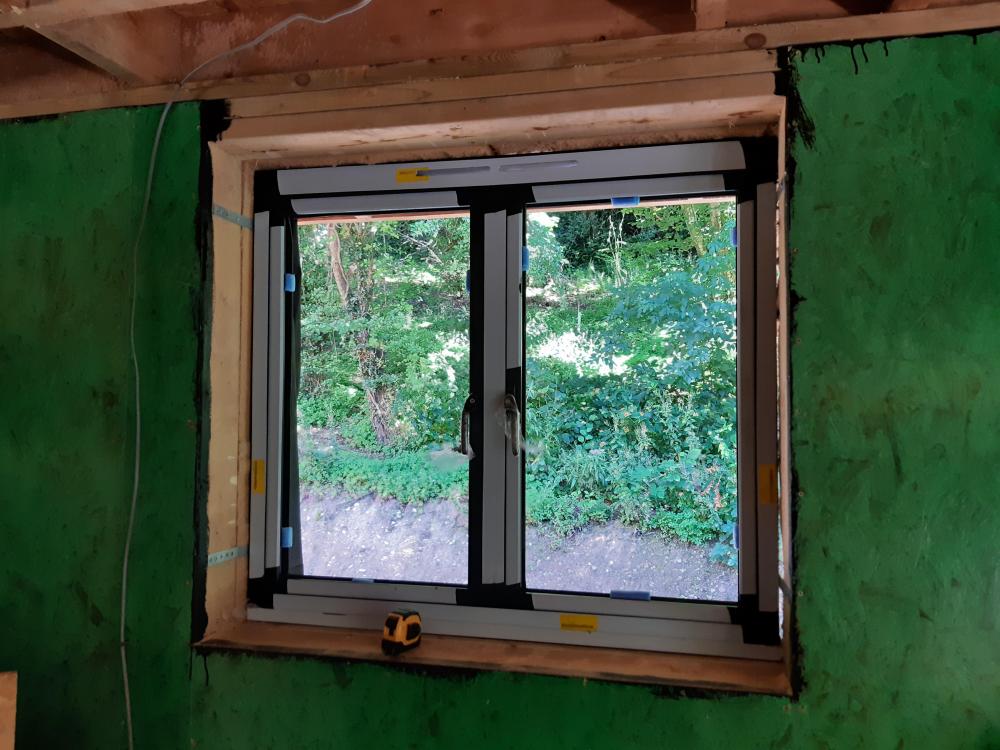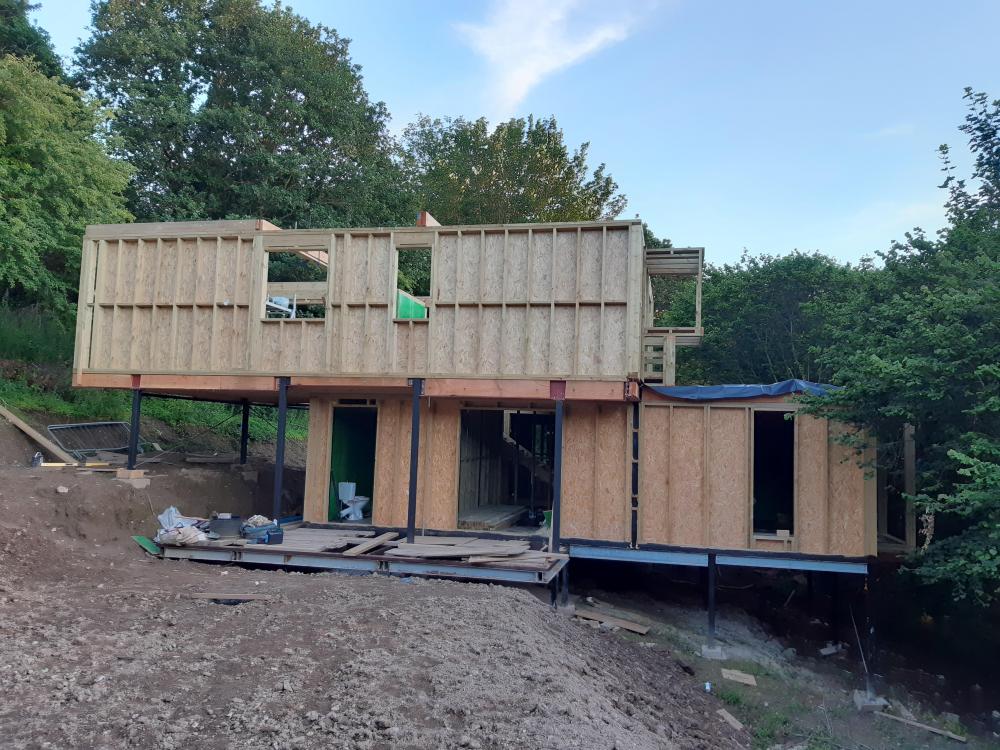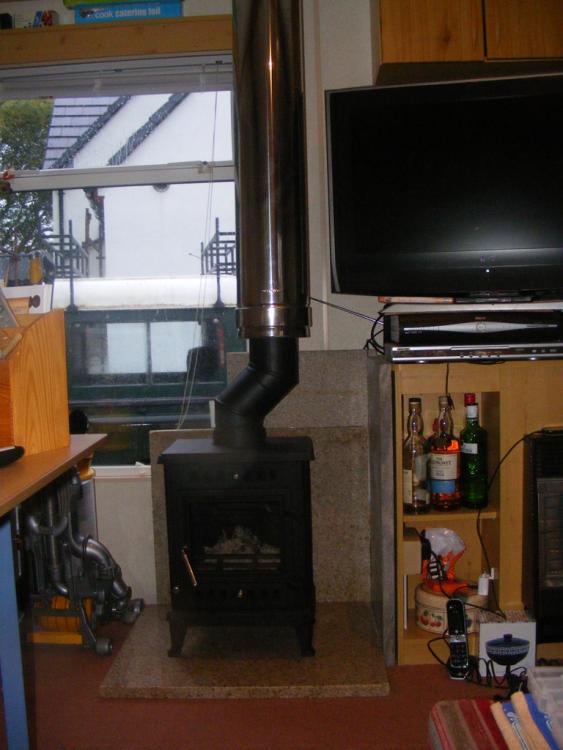Leaderboard
Popular Content
Showing content with the highest reputation on 07/21/20 in all areas
-
Hello everyone, My partner, my son and I have left the flatness of the Essex coast and have bought a little piece of heaven in the West Highlands of Scotland. Basically a 7 acre field, no house, just a ruinous and ancient stone barn. We have planning permission for a new dwelling and for renovation of the barn. We are bounded by the River Aray and have a large pond fed by a mountain burn. There is mains electric on site and a fully filtered ready to go private water supply. The plot was once part of a much larger farm called Ladyfield which features in a few novels by the Scottish author Neil Munro who spent much of his childhood there with his maternal grandmother in the second half of the 1800s. The earliest record we have found so far is of a tenant present in 1812! The house they would have occupied was demolished just a year or so ago but sadly the materials were removed from the site including all the slate which would have been exactly what we needed for renovation of the barn roof. I have spent my life earning money from carpentry/building and from my music. I write and perform my own songs and have toured the UK, parts of Europe and Canada. My partner is an advanced nurse practitioner and walked straight into a job at the nearby doctors surgery. So we are all set to go, well as I actually sit and type we are still waiting our final entry date which is expected to be in the next 48 hours. The plan is to get our static caravan on site and hooked up and get comfy. Then first move will be to get a new roof on the barn and rescue the structure which is all in all pretty sound but with the current state of the roof it is only a matter of time before it deteriorates. Then it will be time to work on the Scottish building warrant and hope to start our build when the weather breaks n the new year. Looking forward to keeping in touch with like minded folks on here and enjoying the ride...3 points
-
Lets start at 9KW ASHP and a 400 litre UVC HP spec from Telford, 75 litre buffer tank and also get the blending set for the manifold (just hope it set up to allow the pipe centres to line up...) Personally, I don't like the pre-plumbed cylinders as they are expensive for what they are. There are circa £250 of bits on the tank and they add over £600 to fit them onto the tank. They assume too that it is wired as S-Plan, which may not be ideal in all instances. With a heat pump setup you are better off using a diverter valve rather than zone valves as there is always an open circuit so you don't get over pressure issues with closed valves. Heat load for the heating will be low, hence the need for the buffer tank as the ASHP will short cycle otherwise.3 points
-
quick update, since our rogue builder departed (police, trading standards and local MP now all involved) we have had some help from a local, brilliant, builder with od days but mainly done it ourselves on evenings and weekends. Now getting roof firrings on, then boards, VPL, insulation and roofer coming 3rd Aug to fit EPDM (the fleece backed stuff). Also windows started being fitted today despite the fact I havnt yet put the external (140mm woodfibre, battons, counter battons and cladding) on yet ? But I can fit it to the windows so that's fine. Drains done, water in house and electric ready to go in. so slowly getting there. Also got to catch up on noggins, etc. A coupld of these pics are from a couple of weeks ago ?3 points
-
2 points
-
This is only a short update because we've been taking it easy on the house so the boss and I can get some (paid) work done. Will be the school holidays soon - so slave labour will be available! I have ordered some plain and simple white UPVC soffits and facia from a local company so time to start measuring up and cutting the splines level. More work for the Alien and some string. The plumb line is made from a Lotus Elise crank pulley bolt! Hopefully the soffits and facia will be installed around the middle of next week. We have some roofing membrane on the roof. About half way there... Just the difficult half to go! My daughter wanted to see the view from the ridge, and who am I to argue? Lets not mention how utterly terrifying this is for a parent! (Even if I was up there moments before!) I have made sure she's been thoroughly chastised over even the smallest transgression when at height and while she's nearly a teenager she will still listen to me over some things. And what a view it is! This is from one of the gable "hop ups" (Why the scaffolders call them this I don't know. You'd need to be awfully tall to hop on to it.) Our neighbours visitied. This is the view from their garden. The green membrane does blend in nicely, so I believe the pale green cladding colour is the right choice. There is still some discussion about the grey window frames.2 points
-
I don't know about regs re cohabitation. But my 2 pence worth. Don't enclose the ASHP in needs plenty of free air flow. And fit a pair of 47kg bottles on an automatic change over not one small bottle that you will curse when it runs out in the middle of cooking and you have to go out and change it manually. Gas is cheaper per kg in the larger bottles.2 points
-
2 points
-
B & D it is then. Hardest option to connect up, but I should be used to that by now! Might as well do it properly ;) Thanks for the advice.2 points
-
Hi Jilly and everyone. Jilly seems to have a common problem in that some builders are not interested, some are chancing their arm and one lacks confidence. To really simplify things. To me self builders often fall between two stones. We know that we can build something, save money, "realise the dream" and have that satisfaction of just doing it yourself. We often have confidence in our ability. This gets you started and a bit down the road. The posts so far are bang on but I have gone back a step to the beginning. I have cobbled this together so it's a bit rough / not polished. I'll get my excuses in for early for the simplistic analysis, but it may be of some use to someone. If you don't know what to do (say cost in Jilly's case) then you can start by ruling things out. This leaves you knowing definitely what you don't want and it can make it easier to decide what you do want. You'll get good advice on this site regarding how you drive down prices, negotiate a contract, specify what you require and how you approach any dispute that may unfortunately arise. But how do you actually get to this point in the first place? A builder may lack the skills needed for the sale but it doesn't mean they are a bad tradesperson! We are not looking for salespersons, we need good competant builders at a fair price. To the experienced members of this site.. remember starting out! How confident / experienced were we then? I try not to not to dwell on that too much, too embarrassing. To get you started with builder the first thing that is worth a try is to get their interest, you often need to appeal to their pocket. Their is a saying that the number at the bottom of a builders invoice is not their registered charity number, it is the vat number. To generate interest you can indicate that you are willing to pay a fair rate and make regular payments. For a small builder this can mean that they will get a bit of bread and butter work which leaves them able to expand or say chance thier arm with someone else in the knowledge that their mortgage is paid, cynical yes. Not all builders are like this and I would urge you to keep an open mind. Some for example just want to make a reasonable living as they may have family commitments that take precedence... they will still do you a great job though. To expand a bit further. A lot of self builders won't / can't afford to pay for a site investigation. In Jilly's case the builder has no idea what they will have to do once they get into the nitty gritty and so will cover their risk. They may worry that should they need to do extra work you won't have the money to pay or become difficult. The variation in price that Jilly mentions is in part to do with how the builder percieves the risk to themselves. In all negotiations it it worth trying to see things as others do. What Jilly could do is to say to the builder.. well if you need to go down and extra two feet what is the rate for every square metre of masonry, how much for the muck away, dealing with any ground water etc and how much profit / uplift will you add to this. You as a customer don't need to be an expert to ask this you just need to get the conversation started. This way you will encourage builders to engage with you. If they don't then maybe give them a miss. Once they do they will often open up and point out other things that could add to or in some cases reduce the cost. Once you have their interest they will often help you, and give good advice as they want to win the job. They will often view you as serious customer and more importantly a fair customer. The firm/ knowledgable /decisive / negotiating type of customer comes later. You will have put in the work and can expect to reap the rewards. If you can garner (fairly) interest from a say two or three builders then you will learn lots from them. You'll start to get some transparency on the price breakdown and then you are in a position to make an informed decision. You may start to see some convergance of the prices and be able to compare apples with apples. You'll get the odd outlier, too high a price and just as importantly the one that is too low, often best to avoid unless you are happy to deal with the spurious claims for extras. What I have outlined above won't suit everyone. However, the construction industry is just as much a people thing as every other field. If this approach suits you then it's worth a try, you've not much to loose other than say a bit of time. You will however learn a bit more and gain confidence by doing so. It does seem that at times the construction industry is more than blessed with it's fair share of chancers and so on. If you take take it one step at a time, learn as much as you can then you'll usually be ok. If you cut corners you run the risk that you may be a bit less lucky. It's all food for though. The quote from Ruskin below is worth a read. With hindsight I suppose I should have just posted this and left it at that! It’s unwise to pay too much, but it’s worse to pay too little. When you pay too much, you lose a little money – that’s all. When you pay too little, you sometimes lose everything, because the thing you bought was incapable of doing the thing it was bought to do. The common law of business balance prohibits paying a little and getting a lot – it can’t be done. If you deal with the lowest bidder, it is well to add something for the risk you run, and if you do that you will have enough to pay for something better.” John Ruskin 1819 – 19002 points
-
Correct. If you are digging more than 3m from their house or outbuilding then you can go down to the 45 degree line (eg at least 3m deep) without involving the neighbour or PWA.1 point
-
Get a spade out and dig down against your outside wall where ever is the easiest spot and find the founds. Next doors will be near enough the same. Then you will know for sure.1 point
-
600mm down for what... your new foundations? If so, that would never be acceptable to Building Control because as mentioned before, the minimum is usually 1m even for single storey extensions. As @Temp has mentioned... if you’re building min. 3m away then you’re pretty much sorted on the foundation front. Unless of course you end up having to pile, which is more so to do with the ground conditions.1 point
-
If you dig more than 3m away you come under the "within 6m rule" rules and the 45 degree rule applies. Example: Let's say you dig 4m away. The 45 degree rule means you can dig down 4m at least before the party wall act applies. In fact you can go deeper because the 45 degree line is drawn from the bottom of their foundations not the ground level. In that case you can dig down 3m without needing to do anything.1 point
-
Ha, he buried everything, I even found bits of triumph herald, apparently he used half the car to drive a circular saw for his firewood ?1 point
-
If you’re excavating within 3m of your neighbour’s building and your foundations will be deeper than theirs, then the PWA would apply. With new foundations having to go down at least 1m, it’s not easy to ascertain the depth of their neighbour’s so you end up serving notice because of the unknown. You can download templates from the PWA yourself and serve those as opposed to appointing a surveyor. The attached should help clarify.1 point
-
Depends on what sort of look you want really. We have glass and like it a lot; cleaning glass beats dusting spindles! Bear in mind that you might struggle to achieve the 'frameless' look pictured in the OP, and will probably need a hand rail.1 point
-
I got a gas bottle trolley going scrap at work. Makes shifting 47Kg bottles around much easier and safer.1 point
-
I have a pair of 19kg gas bottles on a changeover valve next to my ASHP (no cover). I chose 19kg as I find (at my tender age) 47kg a bit weildy, a 19kg on hob only lasts 6 months or more.1 point
-
Welcome and greetings from west coast argyll. Looks absolutely fantastic!!!! What a great barn to have as your staging area for a new build. Really looking forward to seeing your progress.1 point
-
I would personally just put the shed up. the worst that can happen is you will be asked to submit a retrospective planning application. That house is one where the entire garden is between the building and the highway so it could be argued anywhere needs PP. Having put the shed up, when you submit the plans for the extension, mark the shed on the plans as "existing shed" and by default if the plans for the extension are passed then so is PP for the shed. Personally I would fence the garden, but you might want to leave that until after building the extension.1 point
-
OK so this one is even worse - a normal UVC does not need a PHE, and there is DHW external mixing where a 3.3kw internal coil needs no moving parts. It essentially adds another pump and another system to go wrong, with 3 pumps where one would do assuming you cannot remove the circulation pump for the heating system. And at over £2000 for the cylinder that is eye watering..! This can be massively simplified and not require anything close to the components. I have installed a single circuit ASHP that has one diverter valve, one pump and one zone valve. It is run from a standard dual channel controller that is wired in "W Plan" which any plumber could work on as the heat pump needs a single NV switch to trigger the heat pump. That provides all the heat and DHW to a 300 litre UVC and 85sqm UFH setup and it took less than 2 days to install and wire. It cannot get much simpler than this.1 point
-
Well I have a 4 kW ASHP feeding a buffer tank which feeds UFH via blending manifold set to 25’ In the heating season the buffer is permanently heated and when the single room stat in the hallway calls for heat the pump on the manifold is activated. I only have one zone, the whole downstairs. I was recommended a buffer tank to stop short cycling but others here don’t have them with no problem. The buffer tank also has an immersion to give me backup heating if the ASHP is offline for servicing/breakdown, but a Willis heater would provide this backup if I had no buffer. Two reasons fir having the buffer, less inhibitor/antifreeze, and instant access to heat for the UFH rather than waiting fir the ASHP to get up to temp. Buffer tank temp is controlled by tank stat set at 40’. The ASHP set to provide water at 48’ for any use. I have never seen the ASHP defrost. DHW, when the Telford DHW tank calls for heat a signal activates a diverter valve fir the manifold ASHP to heat DHW. I am a Luddite and like simple uncomplicated tech free solutions (less to go wrong IMO) and find my setup works very well.1 point
-
yep, I have loads of photos from the start and would be happy to document it in a blog. I think there are a lot of lessons learnt (well has been for me that's for sure)1 point
-
Wife and I currently living in a static caravan in the garden! We hope to start demolition of the old house we have lived in for the past 20 years as it’s bl***y freezing all year round! With any luck, just awaiting structural engineer calculations, we can apply for building warranty does with extraordinary luck have it passed first time (I’m told there have been sightings of flying pigs ? in Moray! We have already stripped out the interior and can’t wait to make visible progress, even bought a JCB to help with the hard work. Will do our best to keep interested people of progress and maybe share information and resources.1 point
-
1 point
-
1 point
-
1 point
-
1 point
-
Don't over think it. An ASHP is a source of heat. Think of it as a system boiler. That heat connects to either the heating (presumably UFH) or the hot water tank via a couple of motorised valves. That plumbing is withing the capabilities of any plumber worthy of that title. The electrics can be a little more complicated than a system boiler and are very dependant on what make of ASHP you choose. They are not as standard in that respect as a system boiler. But again any electrician that can read the manual should be able to connect it. A good option which is well regarded is the Mitsubishi Ecodan ASHP which can be bought with a pre plumbed matching unvented hot water cylinder. That is probably the most simple system to install. I run my system without a buffer tank without issue but some swear by them.1 point
-
It's a well trodden path doing it that way. Most of the risk of encountering significant issues will occur before the roof goes on. £4k saved is not a bad start. Keep haggling over everything once you take over the reins and the savings will soon mount up.1 point
-
https://www.electrical2go.co.uk/insulated-aluminium-ducting-100mm-x-10m-fxalins-100.html?utm_source=google_shopping&gclid=EAIaIQobChMI1ubAyLnc6gIVj-vtCh1GlgBoEAQYBSABEgLqkPD_BwE Even cheaper again1 point
-
1 point
-
1 point
-
Intake at D, exhaust at B. I will be separating mine by 3m but others have suggested that less is OK. Same elevation. Exhaust down-wind from intake.1 point
-
I was told to estimate £100 a meter for most services across a field but that was 12 years ago so it sounds reasonable to me.1 point
-
I quite liked living in a touring caravan for 16 months haha. The saving grace was ripping out the gas fire and fitting a micro log burner.1 point
-
Can't help with the log build but can offer some moral support wrt living in temp accommodation ! We lived 18 mo in a 40x12ft static in garden with two kids who were late primary school age then. Was pokey but we made the best of it. My top tip is to use a dehumidifier to reduce moisture in the caravan and to provide a bit of background heat, if you use gas heaters you will get a lot of water vapour which will condense out overnight and will leave a cold and damp floor the next day. When you move into your new house, you'll look back on the caravan and cabin and wonder how you ever survived it1 point
-
0 points
-
0 points
-
The bottle of Glenlivet next to it probably helped as well I guess? ???0 points
-
as per @Bitpipe's post - it doesn't really feel like you're getting the most/best out of your architect because you're trying to drive the design - I'm sure any creatives in the group will have seen the I design, you watch pricelist before.... I've worked with a fair number of self builders before, but I've never have someone work like you appear to be, I'm not sure how or why you've engaged them, but it looks like you're paying money to a design professional and then redesigning their design - can you not just sit down around a table with a set of drawings and tell them what you want them to design?0 points






















